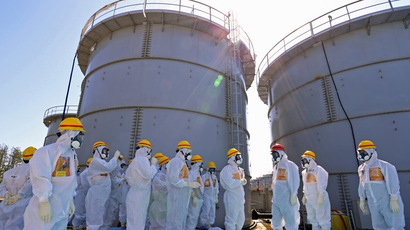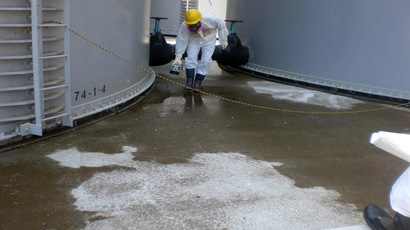Fukushima cleanup workers’ radiation feared 20% higher

Japan’s government may have underestimated by 20 percent the internal radiation doses Fukushima cleanup workers received after the plant’s nuclear disaster, a panel of leading UN scientists says in its preliminary findings.
Three of the Fukushima plant’s nuclear reactors were damaged by
an earthquake-triggered tsunami on March 11, 2011, which led to a
nuclear disaster with the plant accumulating radioactive water
ever since.
The UN Scientific Committee on the Effects of Atomic Radiation
(UNSCEAR) raised doubts about the estimates of radioactive
substances discharged at the plant provided by the Japanese
authorities, plant operator Tokyo Electric Power Company (TEPCO)
and other entities, Japanese newspaper the Asahi Shimbun cited a
preliminary report submitted to the UN General Assembly as
saying.
The UN committee analyzed the data on radiation doses of 25,000
employees who worked at the plant no later than October 2012.
The committee established that the tests conducted on the workers
had failed to account some types of radiation, the newspaper
reported, citing a summary of its report. The procedures
completely ignored incidences of Iodine-132 and Iodine-133, which
have short half-lives of 2 hours and 20 hours, respectively.
Moreover, the workers were tested for thyroid gland doses from
radioactive iodine only after a significant delay, the committee
found.
If the UN scientists’ estimates are correct, then more Fukushima
employees would be eligible for free health checkups and
treatment.
At present about 1,100 people subjected to radiation of 50
millisieverts or more in whole-body doses are entitled to free
tests for cancer of the thyroid gland, lungs, stomach and colon,
the Asahi Shimbun reports. About 2,000 people with whole-body
doses below 50 millisieverts but thyroid gland doses of 100
millisieverts or over are entitled to be tested for thyroid gland
cancer.
UNSCEAR has said that the soonest the report will be completed is
by the end of the year.
The Japanese Health Ministry required TEPCO and 81 primary
contractor companies to submit medical examination results for
20,000 Fukushima employees before December 2011; however it is
still waiting for that data, the Asahi Shimbun reported.

The newspaper also reported that the UN experts cannot check all
thyroid examination results, as the database is incomplete. An
unnamed expert told the paper that radiation exposure in the
Fukushima disaster came in large part from radioactive iodine,
which tends to accumulate in the thyroid gland. Exposure to
radiation is linked to greater rates of cancer and thyroid
disorders.
Japan holds 1st nuclear plant drill since 2011 disaster
Over 3,000 residents of Kyushu Island took part Saturday in the
first day of a two-day nuclear safety training exercise focused
on the Sendai nuclear plant in Kagoshima. In addition to local
residents, officials from about 130 government institutions,
including members of the prime minister's office and PM Shinzo
Abe himself, participated in the first drill since the Fukushima
crisis.
Residents living within a 30-kilometer radius of the plant took
part in an evacuation drill for the first time.
The exercise began Saturday morning under the simulated
conditions of an earthquake, with an intensity of upper 6 on the
Japanese scale of 7, striking an area near the Sendai nuclear
plant, causing one of the plant’s reactors to shut down. On
Saturday afternoon, the plant was simulated to have lost all
electricity due to an aftershock.
Rescue teams worked on news video reporting on the earthquake to
alert people about the accident and show optimal evacuation
routes. The exercise was also attended by members of the Coast
Guard, who had evacuated the residents of remote islands of the
supposedly contaminated area.
Since the Fukushima nuclear disaster, Japan has shuttered all of
its dozens of nuclear power plants. However the Japanese
government is considering restarting some reactors in the event
of their compliance with new safety standards developed after the
March 2011 disaster. Four Japanese power companies have
already applied for the restart of six reactors at 12 nuclear
power plants.
However it is not known whether local authorities will agree to
reopen the plants, because after the nuclear meltdown of
Fukushima’s reactors, public movements calling for a complete
rejection of nuclear power have become more popular.
A preliminary decision on whether to reopen the nuclear plants is
expected in early 2014.














